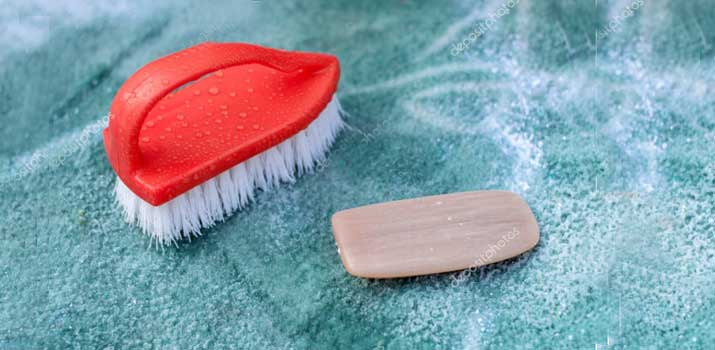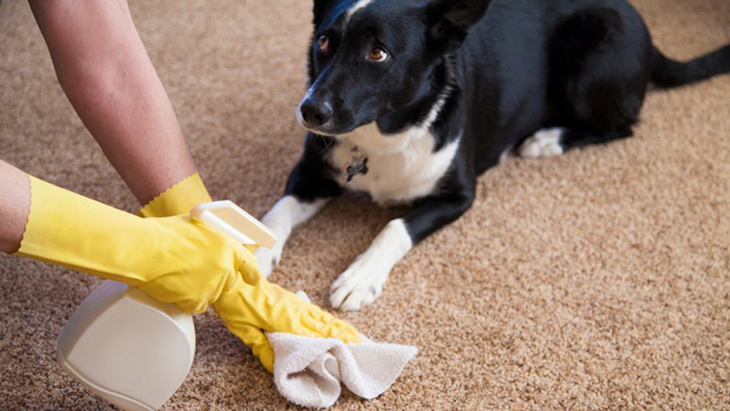
Despite the joy they bring to people's lives, dogs can be messy creatures. They slobber, they shed hair, and they can leave your home a mess through their rambunctious play. One of the biggest messes your dog can leave behind is diarrhea.
Accidents happen all the time. It's a part of dog ownership that you just have to deal with. While diarrhea is pretty easy to clean off of solid surfaces, what if your home is carpeted?
Diarrhea can cause significant damage to carpeted surfaces. It can seep into the fibers, resulting in lasting stains and offensive odors that stick. Luckily, there are ways to make your investment look brand new. If your dog has an accident on the carpet,
here are a few things that you can do to get rid of all signs of a mess.
Gather Supplies
Having supplies on hand can make a world of difference in the cleanup process. Diarrhea stains should be addressed as soon as possible. You can minimize damage
if you take action before the mess has had time to set in. You'll need a few essentials items to get the job done.
Gloves
Protect your hands and fingers! You should never handle feces with your bare hands. Diarrhea is filled with harmful bacteria, so you'll want to invest in some latex gloves to create an effective barrier against the mess.
Cleaners
There are a number of products on the market that are specifically designed to get rid of puppy accidents. [easyazon_link identifier="B00CKFL93K" locale="US" tag="dailydogg-20"]Enzyme cleaners[/easyazon_link] are the best option. They speed up the chemical reactions of the cleaner and can help break down the excrement for removal.
*It should be noted that many commercial cleaners have a strong odor and powerful chemicals that could affect children and pets.
If you're looking for something a bit gentler, you can also use items that you already have around your home.
Dish soap, rubbing alcohol, white vinegar, and a range of other products can be effective if used properly. Products like baking soda and hydrogen peroxide are also recommended.
Wipes
You're going to need a lot of soft products to absorb as much of the mess as possible.
Paper towels are a tried and true go-to for many dog owners. They're easy to work with and can be disposed of in a plastic bag.
Baby wipes are also suitable and may help to mask the smell. If all else fails, you can use a thick cloth. However, keep in mind that you'll have to clean the mess out later.
Vacuum or Steam Cleaner
Diarrhea is not easy to get rid of with your hands alone. Powerful cleaning machines can remove any bacteria that are left behind.
A vacuum that's designed to pick up dog hair is ideal as it's built to get deep within the fibers.
Your best option is to use a steam cleaner. It'll use heated water to sanitize your carpet so that you can feel comfortable using the surface again.
Cleaning Up Wet Diarrhea

The moment you've noticed that your dog has had an accident, take them outside. Diarrhea can strike at a moment's notice.
Dogs that are experiencing gastrointestinal upsets often have multiple accidents, so keep them secured outside so that no further messes occur.
Once your dog is taken care of, it's time to slap on a pair of latex gloves and get to work. The first thing you'll need to do is remove the feces that's sitting on top of the carpet.
It's important that you do this carefully so that you can avoid spreading the mess out more.
Use a paper towel to scoop up some of that mess and dispose of it in a plastic bag. If you need something firmer, consider using a paper plate. Carefully scrape it up without pushing the mess further into the fibers.
Blot Away
At this point, you should use a paper towel to absorb as much diarrhea out from the carpet as possible. Lightly press the paper towel onto the surface. Avoid rubbing at all costs.
Doing so will separate the carpet fibers, causing the mess to fall in deeper. Spray your cleaning solution onto the affected area and continue to blot up the moisture.
Once it looks like most of the diarrhea is gone, let the area dry out completely. You may have to repeat the process a few times to get rid of it all.
Simply spray your cleaning solution, blot up the moisture, let it dry, and repeat.
When all of the mess is finally gone, use your vacuum to pick up any leftover grime and speed up the drying process.
Cleaning Up Dried Diarrhea

So you come home to find out that your dog had an accident many hours ago and the mess has started to dry out. There's no need to worry. Cleaning up dried diarrhea is relatively simple. You'll just need to rehydrate the mess so that it's easier to pick up.
Start by removing any large pieces of excrement that have started to harden on the surface of the carpet. Then, create a hydrating mixture.
In a clean spray bottle, mix together equal parts white vinegar and water. The acidic vinegar can break down diarrhea while the water will loosen it up from the fibers.
Use the spray bottle to fully saturate the affected area. Let the mixture soak into the carpet for up to ten minutes. Once the diarrhea is wet again, you can start blotting it up and applying more cleaner like normal until it's all gone.
Addressing Stains
Even if you spend a significant amount of time attempting to remove diarrhea from the delicate fibers of your carpet, you may be left with an unsightly stain. The area may appear discolored after drying.
If that's the case, you should take steps to preserve your carpet and remove the stain. There are some commercially available stain removers out there. However, you can also use hydrogen peroxide.
Just drop the peroxide onto the stain and leave it to dry. You don't want to fully saturate the area. Instead, just cover it up and let the peroxide do its thing. If the stain is very noticeable, you can create a cleaning agent.
Simply dilute the peroxide with a bit of water. Spray the area with the mixture and sprinkle some baking soda over it to start a chemical reaction.
You can use a stiff bristle brush to work the mixture into the fibers. Let it sit for an hour, remove the mixture, and blot up any moisture.
Addressing Odors
If you've followed the previous cleaning steps, most of the odor should be gone. However, you may still notice faint odors around the area.
This is likely due to leftover bacteria and tiny bits of fecal matter that you can't see. It's important to take care of odors.
If you don't, your dog may return to that spot for future relief. Once that diarrhea hit the carpet, it essentially became your pup's territory. To avoid additional messes, you'll need to get rid of all smells once and for all.
One of the best ways to tackle odor is to use a steam cleaner. Even a small handheld steamer is effective. The heat will sanitize the fibers, loosen up any leftover mess, and leave your carpet smelling great.
Go over the affected area a few times with the steamer and follow up with a traditional vacuum for the best results.
Alternatively, you can use soapy water. Add a few drops of antibacterial dish soap or laundry detergent to some cold water and spray the solution onto the affected area.
With either a stiff brush or gloved fingers, work the mixture into the fibers and develop a good lather. Now, use clean water to wash the soap away and blot up excess moisture.
Conclusion
Sometimes, diarrhea messes are unavoidable. Dogs aren't always able to make it outside before the discomfort and need for relief hits.
While dealing with diarrhea on your carpet isn't fun, you can take care of the problem on your own with a little bit of elbow grease.
You'll be able to save money on cleaning costs and keep your carpet in good condition.

